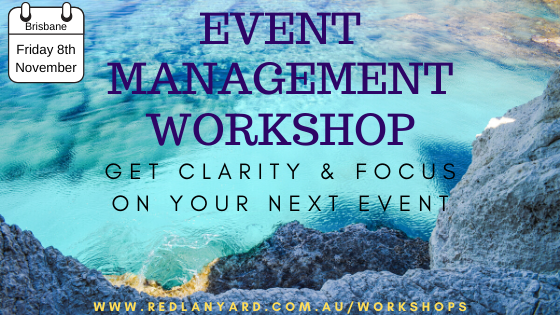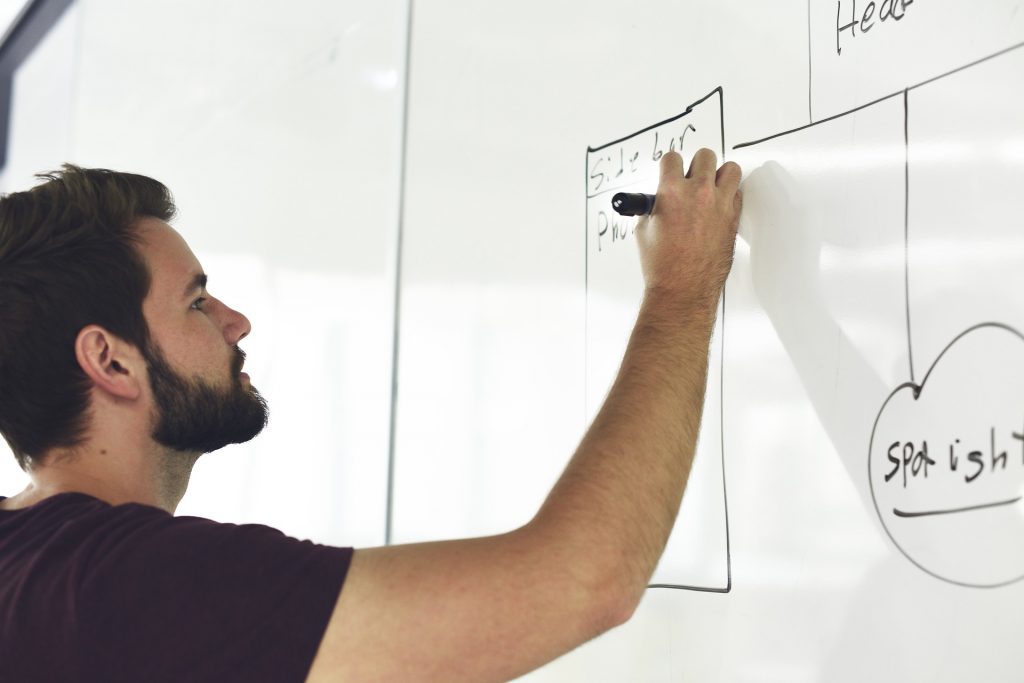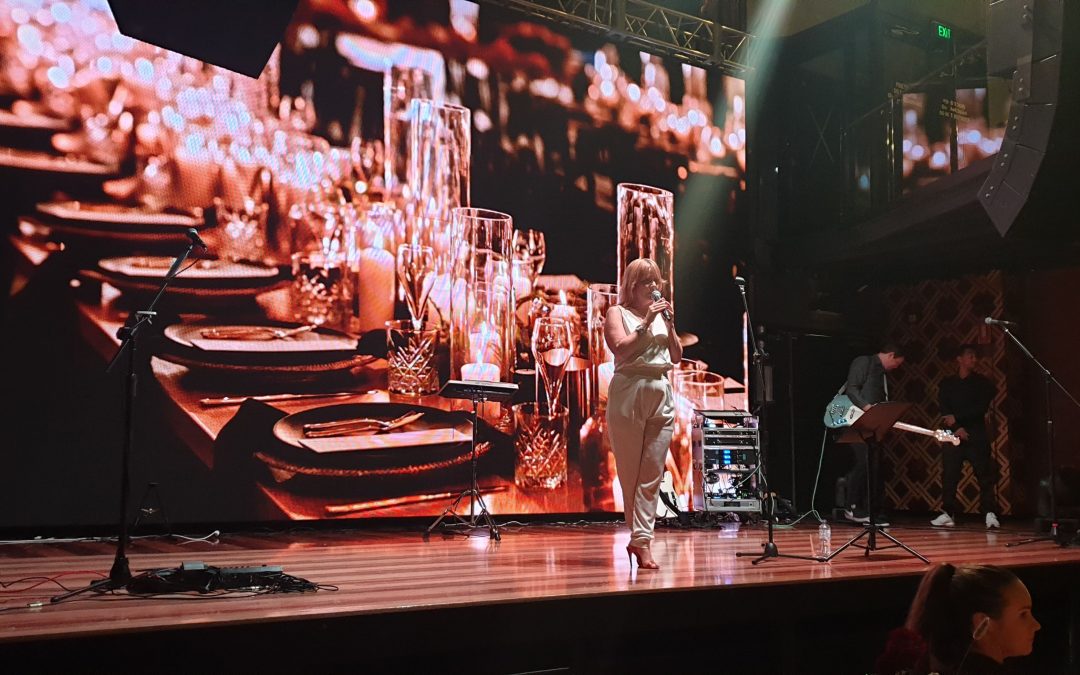Here I am at a local venue to listen to an industry leader share their insights in a field that I have recently taken a lot of interest in. It’s advertised as a workshop and I’m excited about what tips I will take away. It’s free to attend but I’m not sure if any refreshments will be provided or there will be a cash bar. No doubt there will be a sales pitch at the end.
I see a pull up banner advertising the speaker I am here to see and there’s an unmanned registration desk that has name tags layed out on it. They’re not in any particular order but I eventually find my name and notice a bowl with a sign to drop in my business card for the lucky door prize.
I’m greeted very warmly by the venue staff who indicate to me where the refreshment station is, so I head over to make a cup of coffee. There’s at least 60 people in the room, which is set theatre style, and the tea and coffee station is in the back corner.
People are getting their refreshments, some are talking, but most have headed straight to a seat – in the back row, and I join them. I see someone that looks like the Presenter, at the front of the room mucking around with cables, trying to get a laptop to work, while a guest who is in IT helps them try to get the sound working. Eventually it’s all up and running, and the last of the guests takes their seat and the presentation starts.
Presentation over and I leave the event feeling like I have wasted my time. I also have a lecture pad full of notes on how this Presenter could have produced a much better workshop and achieved the follow on business they were attempting to garner.
Was that a sales seminar or a workshop?
Yes that’s right, this was a sales seminar, not a workshops where some information was shared, some sales pitches thrown in for good measure, and then a little bit more information. There were no informative stories, case studies or solutions, just sales pitch after sales pitch. In fact it was so filled with sales pitches, I could probably sell you the product right now.
I couldn’t let this person go on destroying their brand in this way, so I called them and offered to meet with them and share how I thought they could have produced a much more effective workshop, and sold their product at the same time.
Here’s what I told them.

- Begin the journey from the moment I have booked. After you see my registration come though, email me to say thanks! Make it as personal as possible and you could even suggest I send through any burning topics I am hoping to hear about on the night. Send me a reminder 7 days prior to the event, and again on the day before. We’re busy, we forget, and because it’s free, sometimes we care less if the communications are “faceless”.
- When I arrive at the venue, make it really easy for me to find the room that the event is in. Get your branding up in as many places as possible, not just a pull up banner at the meeting room door. Venues often have TV screens around with either wayfinding signage or “what’s on”.
- Give your logo to the venue so they can display it for you. And while you’re at it, ask them what other promotional opportunities they may have, such as newsletters, TV screens in cafes, newspaper and radio advertising, and of course social media. If the venue you have booked doesn’t do any of these things, it might be a reason to choose a venue that does have a marketing program you can tap into.
- Once I’ve found the room, your registration desk MUST be manned. Even if it’s by your son or daughter! A friendly face to welcome me, help me find my name tag and point out where the toilets are, goes a long way to giving me a good first impression.
- And still on the registration desk, you need to explain what will happen with my business card after you have taken it home. What will you do with my information? Do you need to ask my permission to add me to a database? Or is it implied by me dropping my card into the bowl. It’s important to be clear.

- If there’s room, put out some sales information that I can pick up and take in with me. Once I’m inside, I may not be comfortable to speak with strangers straight away. It’s good to have a distraction like reading a brochure, while I get my bearings. It also gives me something to open a conversation with someone about. “Hey, my name is Sally, did you know that George practiced these amazing NLP techniques?”. You get the drift.
- Another tool to have INSIDE the room is a table that has your brochures, products or information displayed so again, there is something to distract me if I don’t feel like talking to strangers. It gives me the sales pitch to take home, and I can then just focus on tonight’s content.
- But most critically, YOU should be at the refreshment station, mingling, networking and introducing guests to each other. You know who they are, you know where they have come from, and you know if they have similar interests (and side note, they do, they’re both here to listen to you…). Help people meet each other, they will have a richer experience for it, and your workshop will be more memorable for it.
- BUT you shout, I’ll be sorting out the AV and getting my presentation ready! No you won’t because you will have done the following on arrival, at least 1.5 hours prior to doors opening;
- Checked the signage around the venue to ensure it is correct
- Set up your registration desk, name tags (in alphabetical order by surname) and marketing collateral. As well as business card draw information, and if you’re taking photos at the event, a sign advising guests that their photo may be taken and used for promotional purposes.
- Check that the room is set to your specifications. And here’s a tip, if you’re producing a workshop, this implies I will be working, please provide me with a desk. Balancing a notebook on my lap is not a workshop, it’s a presentation. So, the room should be set with either open rounds or classroom style, ensuring there is room for notebooks, laptops, workbooks, etc., per person.
- Make sure you have a variety of technical cables at your disposal. Don’t assume the venue has the right connection for your laptop to the projector. Not all venues are the same, and they most certainly are not all stocked with the latest equipment. Talk to a venue technician and ask them what you should have in YOUR kit to make their job easier. A happy technician is a flawless production.
- And on this note, that means not showing up with 5 minutes to doors, expecting them to be able to just plug and play. Not showing up with your presentation on a USB and expecting them to just plug it in and start. A presentation is professional when it is rehearsed, even 1 hour before doors. Ensure you leave time for a rehearsal and a sound check (they’re not just for rock bands).
- Either hook up your own laptop or make sure that the one provided works effectively and your presentation shows the same way you expected it to. Make sure all embedded videos run as expected, that the sound comes out as expected, and that you’re capable of navigating the wireless pointer and slide changer you have been provided. Or if you haven’t been provided one and someone is changing slides on your behalf, work out your cue to them, both for indicating whether you want them to go forward, backward or to the end. Here’s a tip, think of hand signals just like in baseball – inconspicious but effective.
- Check that your microphone works, any room light changes you may need are cued, with someone there to take care of it for you
- Do a complete run through of your presentation and try to get this done with at least 15 minutes to spare so you can take some time to relax, get into the right head space, and welcome your guests with the warmth and generosity you intended.
- Throughout your presentation, it’s ok to pitch your products and services to your guests. They are EXPECTING it! You can either do this throughout, as a section at the end, or before questions. It really depends on your audience and the complexity of your product or service, but make sure that you do it. Same that you should acknowledge any sponsors, partners or people in the room that helped you produce the event. Tell people about their products and services too, and don’t forget to give them the takeaway information.
- The takeaway information….
- Social media page names, hash tags and twitter handle prominently displayed on EVERYTHING! Including slides, handouts, collateral and business cards.
- Physical collateral such as postcards, brochures or stickers
- Business cards with email address, phone number and website
- Handouts of your presentation (after you have given it of course)
- Informaton about what they need to do next – ie’ sign up for a newsletter, the next course, another information session, working with you, etc.
- And how do you make sure your guests get all this information? You will be standing at the door shaking everyone’s hands as they exit, giving them a gift bag with all this information in it. Everyone loves a GIFT BAG and if you have them on the registration table on the exit, you can be sure 100% of guests will grab one, we can’t help ourselves! So if you miss the chance to speak with me, you know I will have your information, to continue the conversation. It also gives you the opportunity to email me in a few days and ask me if I’ve had time to read it – it just provides a touch point to keeep the conversation going.
Where to Get help
So next time you want to promote your products or services, by sharing some knowledge with people, think about delivering a workshop, paid or free that not only gives them knowledge and tools, but also demonstrates for them, when it’s important to call in a professional.

Google (and our parents) has convinced us that WE CAN DO ANYTHING, which we translate to everything, and while we’re pretty clever, it’s good to know, at what point we should call in a professional. Make sure you’re the first professional that comes to mind when they need one.
If you would like to workshop your very own workshop,
check out www.redlanyard.com.au/workshops for more information.
Or email me at sally@redlanyard.com.au or call me on 0408 887 106.

